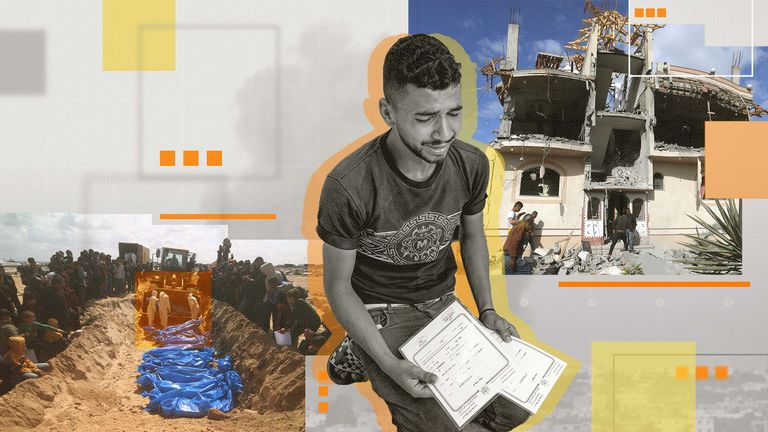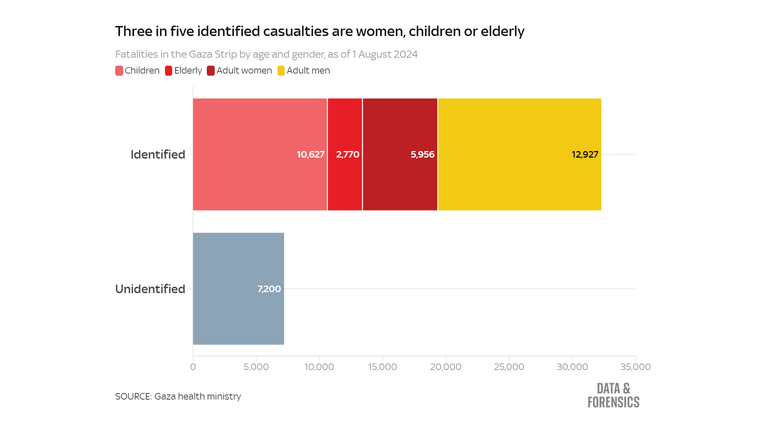Gaza conflict: Thousands remain unidentified as death toll reaches 40,000
Israel disputes the figures provided by Gaza's health ministry, but experts say they are reliable. Sky News obtained new details about how the data is collected, and why so many of the dead remain nameless.
Thursday 15 August 2024 15:42, UK
More than 40,000 people have now been killed in Gaza, according to the territory's health ministry.
A further 92,401 people have sustained injuries, health officials in the Hamas-run enclave say, meaning one in every 17 people in Gaza has been killed or injured since the war began (5.8%).
Fidaa, 39, and her children were sleeping in a school in central Gaza when the shells hit. Her brother Yousef, 30, and husband Abed, 43, were sleeping in the nearby men's section.
Hours earlier, they had all been eating together in the courtyard - "chatting, playing, telling jokes," Fidaa says.
She ran downstairs to see fire "covering the sky". The men's section had been hit.
"Imagine - at that moment my children ran towards the fire to help their father and uncle," she says.
"They were charred corpses and body parts. I wasn't able to give them a proper burial."
Ten months of war between Israel and Hamas have devastated the Gaza Strip. An estimated 59% of buildings have been damaged or destroyed, including more than 215,000 homes.
It's not clear how many of those killed have been civilians. On Thursday evening, IDF spokesman Daniel Hagari said that Israel had so far "eliminated" 17,000 Palestinian militants.
Gaza's health ministry doesn't distinguish between civilians and combatants in its count of the dead. Of those which have been identified, however, 60% are women, children or elderly people.
The Israeli and US governments have cast doubt on the statistics produced by Gaza's health ministry, which remains under the control of Hamas.
In May, Israeli foreign minister Israel Katz described them as "fake data from a terrorist organization".
In response to its critics, the health ministry has repeatedly published the names, ages and ID numbers of all identified fatalities.
"That's important because those [ID numbers] were originally assigned by the Israelis," says Professor Michael Spagat, chair of Every Casualty Counts, an independent civilian casualty monitoring organisation.
"So, the Israelis can easily check to make sure that those are real people that are in the population register that the Israelis maintain."
When Sky News asked the IDF if it had performed any such checks, its spokesman declined to comment.
Thousands of fatalities, however, remain unidentified - without names or ID numbers.
Speaking to Sky News, the man in charge of collecting Gaza's mortality statistics says his team have been working hard to put names to these bodies.
"We're facing a great challenge over the credibility and transparency of what we publish," says Zaher Al Wahaidi, director of the health ministry's Health Information Centre (HIC).
How the system collapsed
Before the war, the HIC was able to track deaths in real-time via a computer network which connected hospitals across the Gaza Strip.
The system had proven accurate during previous conflicts, its figures tallying closely with estimates later produced by the UN and IDF.
"The way that the health ministry has reported deaths in past conflicts deaths is quite strong - much stronger than other settings that I've worked in," says Professor Paul Spiegel, director of the Center for Humanitarian Health at Johns Hopkins University.
Mr Al Wahaidi says the system collapsed following Israeli raids on Gaza City's Al Shifa and Al Rantisi hospitals last November, raids which destroyed the HIC's data centres.
In the south of Gaza, hospitals lost access to the civil registry - the national database of names, ID numbers and birth dates. These details now had to be entered manually, which meant that thousands of ID numbers, names and dates of birth were missing or entered incorrectly.
The situation was far worse in the north, where there were no computer systems at all. Staff relied on pens and paper to record the details of the dead. When the hospital was particularly busy, this was impossible.
Instead, a simple headcount was taken by the hospital spokesperson. Bodies were tagged and photographed for later identification.
As a result, the number of unidentified fatalities rose rapidly. In March, 81% of all new additions to the death toll were unidentified.
In the health ministry's reports, these body counts were attributed to "reliable sources" - a phrase which has previously been mistranslated as "reliable media sources".
"It's not from journalists," says Mr Al Wahaidi. "We don't depend on any press sources for data - this is the policy of the Ministry of Health."
The situation in the north only began to improve in February, as computer systems were gradually restored.
It took many months longer until Gaza's hospitals were able to reconnect to the central database of the HIC, and send detailed data automatically.
Now, all of Gaza's major functioning hospitals have been reconnected.
Identifying the dead
Many of these hospitals have since been able to supply data on people who were killed during the communications blackout.
For hospitals in the north, this has come in the form of paper notes which, Mr Al Wahaidi says, took two months to digitise. He and his team have also had to fix thousands of entries containing typos or missing data.
Sky News analysis found that the number of entries with missing or invalid ID numbers reached as high as 2,769 in early April. By the end of July, however, it had fallen to just 313.
More difficult, says Mr Al Wahaidi, have been those fatalities for which no information is available.
To identify these cases, Mr Al Wahaidi and his team have relied on an entirely new system - one which allows the families of those killed to obtain death certificates without a body.
The families are required to fill out an online form with the details of the deceased, and to say whether their body was received by a hospital.
Data from July shows that 55% of fatalities reported via the form had passed through a hospital but were not identified. A further 22% were buried without reaching hospital, while 23% were missing or presumed to be under the rubble.
If a death is confirmed, Mr Al Wahaidi and his team add it to their database. If the body passed through a hospital, one entry is also removed from the tally of unidentified deaths.
For a death to be confirmed, however, the family must first put their case before a judge.
"All residents of northern Gaza must go to a judicial committee in Gaza City. All residents of southern Gaza go to one in Nasser Hospital, in Khan Younis," says Mr Al Wahaidi.
"After that, they're referred to the public prosecutor to verify that the event occurred [and that] the one they're registering was actually a martyr, and not a natural death."
A total of 6,187 deaths had been confirmed via the online form as of 6 August.
Collecting this data has allowed the HIC to put names to many of the previously unidentified bodies, and to provide the families of the deceased with death certificates.
By 31 March, the number of unidentified fatalities had reached 15,070 - 46% of all deaths. As of 6 August, this had more than halved to 7,200 (18%).
"It's all very challenging and chaotic and you would expect there to be plenty of mistakes," says Prof Spagat.
"But it looks like they're in there fighting the battle to record all this information, and they seem to be doing it in a serious and reasonable way."
It may be years before the true number of deaths in Gaza can be determined. Israel has denied almost all access to Gaza by international journalists and investigators.
Mr Al Wahaidi says the number his team are providing is intended to be a conservative figure, based only on those deaths which have been confirmed by medics or by a judicial process.
"We're still missing many people that haven't been counted," says Prof Spiegel, of Johns Hopkins University.
"And the health ministry is only reporting trauma deaths. There's clearly [been] an exacerbation of indirect deaths - cardiovascular diseases, diabetes, maternal deaths. If anything, I think it's an underestimate," he adds.
The Data and Forensics team is a multi-skilled unit dedicated to providing transparent journalism from Sky News. We gather, analyse and visualise data to tell data-driven stories. We combine traditional reporting skills with advanced analysis of satellite images, social media and other open source information. Through multimedia storytelling we aim to better explain the world while also showing how our journalism is done.









